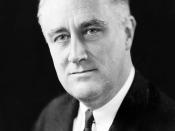The Home Front in America
President Roosevelt felt by this time that it was only a matter of time before the USA was drawn into the war. Roosevelt was facing an American public that wanted nothing to do with the war, however. He made several moves that would help the US prepare for that day. On Sept 16, 1940 the United States military conscription (draft) bill passed.
FDR (the common reference to Franklin Delano Roosevelt) also was greatly concerned about the Battle of Britain. Most in the government knew that if Great Britain fell it would allow Germany to capture all of Europe. FDR was able to get several bills through Congress even though Americans were loudly protesting.
Destroyers-for-Bases: FDR traded 50 American battleships for British territories (mostly islands like the Bahamas and Jamaica) in the Western Hemisphere.
Lend Lease Bill: FDR began to call the USA the "arsenal of democracy."
The idea behind Lend Lease was that FDR would let other countries borrow military supplies that would be returned later.
Convoying: FDR ordered the US Navy to protect all ships entering and exiting US ports.
Atlantic Charter: An agreement between Churchill and Roosevelt to defend each other's countries in the future.
In response to these moves, the American public grew more vocal in their opposition to any US involvement in the war. The most notable organized group was the America First Committee The main argument of the group was that the USA was not the "world's policeman." Many notable Americans were part of this group. Henry Ford and Charles Lindbergh to name a few.
FDR and his cabinet were convinced that it was only a matter of time before the US was in the war. The German navy had attacked American ships involved in convoying duty and the...


